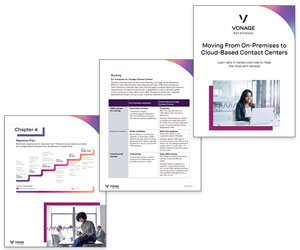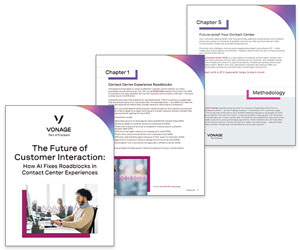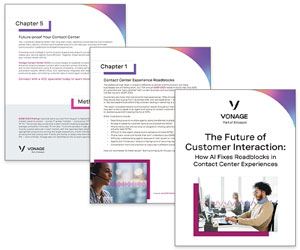Vonage has unveiled new research that shows businesses have technology gaps that prevent them from making meaningful connections with customers.
After two years of non-stop digital transformation among businesses, only 45% of consumers are “very satisfied” with the way they connect with companies, revealing opportunities to enhance digital transformation efforts with omnichannel communications channels, artificial intelligence (AI)-driven capabilities, and more.
Vonage’s 11th Global Customer Engagement Report, based on a survey of nearly 5,000 consumers from 11 countries, explores preferences when it comes to using technology to connect with their favourite brands.
Consumer Expectations and Satisfaction
The report found that 60% of customers are “very satisfied” with friends and family communications, while 45% rate business/service provider communications as high.
While many consumers use messaging apps such as WhatsApp and Facebook Messenger (57%) and make calls via messaging apps (48%) with friends and family on a daily basis, the study uncovered that phone calls (37%) tend to be consumers’ most-used method for communicating with businesses, followed by email (30%) and messaging apps (30%).
This disparity suggests that businesses are not providing consumers with the same, familiar experience they are used to in their personal lives when it comes to communications technology.
In order to do that, businesses need to drive omnichannel customer engagement forward (voice calls, video, chat, messaging apps, and more) and embrace emerging technologies like AI, to eliminate common customer frustrations and technology gaps.
“The ubiquity of mobile phones delivers the kind of vehicle to businesses that allows them to speak to and engage with their customers directly — right from the palms of their hands.
“Yet this research reveals that many businesses are still not using the communications channels made available by today’s technology to their full potential and are missing out on opportunities to make real connections with customers and drive customer engagement,” said Joy Corso, Chief Marketing Officer for Vonage. “This is where AI tools can help and surface as underused technology.”
AI tools like virtual assistants, for instance, can address common requests and eliminate long wait times for customers. Virtual assistants can also provide the initial triage to route customers to the right person — which is helpful during peak or seasonal periods.
Another tool is conversational commerce, which uses AI to engage customers in-channel. Companies can use it to add information, automation, and self-service to conversations. For example, companies can provide front-end FAQs, authenticate users, and authorize payments.
“In this age of digital transformation, as more businesses work to improve and simplify the customer journey, AI-powered technologies such as virtual assistants, programmable voice, chatbots, and conversational commerce are letting customers take control of their preferred communication channels,” said Dan Miller, Lead Analyst and Founder, Opus Research.
“With this year’s instalment of the Global Customer Engagement Report, Vonage is shining a light on the importance of personalized, real-time engagement as the key to driving enduring brand loyalty.”
Common Frustrations and the Way Forward
The data reveals several top customer frustrations in making meaningful and effective connections with brands, including:
- long wait times to speak to a customer support agent (63%)
- having to call customer support multiple times (63%)
- repeating their issue (61%)
- dealing with automated phone menus that are too long to navigate (57%)
While these frustrations are not new, they remain top of mind for consumers, and businesses need to remedy this before it negatively impacts customer loyalty.
Brands will need to act quickly, as nearly half of those surveyed noted they are likely to leave or switch businesses after just one or two frustrating experiences.
Brands can quickly remedy some of these issues through the help of AI capabilities: automation and personalization using virtual assistants, conversational commerce, voicebots, interactive voice response systems (IVRs) or automated business phone systems, and more.
Purchase Channel Preferences
Surprisingly, globally, the respondents indicated that physical in-store remains the most-preferred purchase channel (45%), followed by ecommerce (39%), phone calls (38%), and email (36%).
While phone calls and email are widely preferred channels across all stages of the purchase process, website chat is preferred mainly for asking questions while shopping and getting answers to problems during a purchase.
This isn’t surprising as today’s consumer needs and demands real-time, contextual, and seamless support at every step of their customer journey. This represents another area of opportunity for businesses to address to ensure exceptional customer experiences.
Key Consumer Engagement Insights by Region
While the 2022 Report shows slight variations in consumer satisfaction and preferences by region, ultimately there are the same gaps in personal engagement versus brand engagement experiences.
- Latin America has the highest daily usage of many communications types when engaging with friends and family via messaging apps (83%), phone-call apps (77%), and social media comments (64%), compared to usage when engaging with businesses over messaging apps (50%), phone-call apps (49%), and social media comments (46%).
- North America leads in daily personal SMS usage (67%) but shows a marked decrease when using the same mode of communication with businesses (33%).
- The United Kingdom is behind other regions in daily mobile phone calls (46%) and email (37%) communications when communicating with friends and family, but these numbers decrease even more when connecting with businesses by mobile phone calls (24%) and email (20%).
- While there is wide diversity within Asia Pacific in daily communications, overall data is consistent with other parts of the world. For example, personal usage of apps for both messaging (48%) and phone calls (47%) is significantly higher than connections via apps for messaging (31%) and phone calls (32%) with brands.
Added Corso, “The pandemic made the call for digital transformation louder than ever before. Whether it’s messaging, chat, video, or AI-powered conversational commerce, consumers expect to connect with brands in the same way they connect in their personal lives — through whatever channel they are in and where they are most comfortable.
“There is a tremendous opportunity for businesses here. Quite simply, businesses should be communicating more like family and friends. That is the experience that will drive customer engagement and keep customers coming back.”
Read the full Vonage Global Customer Engagement Report 2022 for more insights
Author: Robyn Coppell
Published On: 28th Oct 2022 - Last modified: 19th May 2023
Read more about - Industry News, Vonage



















